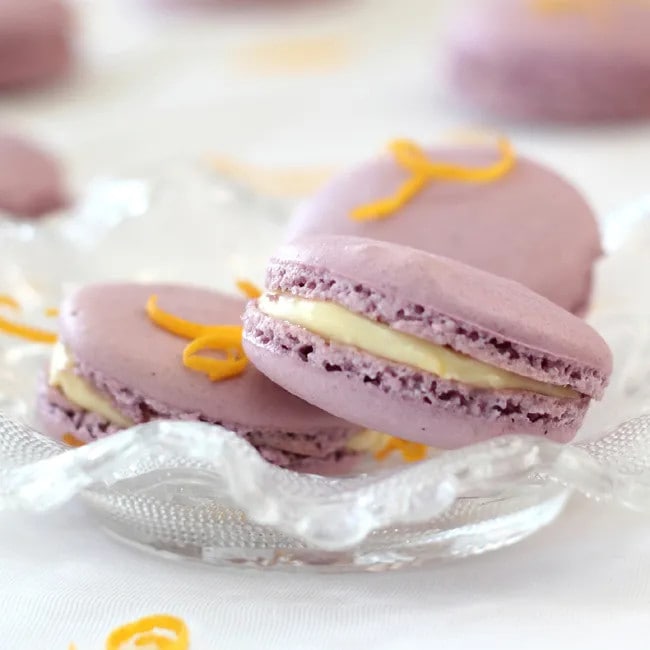Boy, these are tricky little numbers. I’ve probably made about four batches of French macarons over the past few months and while they’ve gotten better each time, they’re still not what I’d call perfect. The problem is, there are so many things that can go wrong, dammit! Macarons are finicky about oven temperatures, how much they’re mixed, how long they’re baked, even humidity. Every time they’ve failed to grow feet, had hollow shells, left their innards on the baking paper, or cracked their heads, I swear it’s the last time I’m going to make them! And, yet, something compels me to try again. Perhaps it’s because perfection or not, these babies are delectably, diabolically yummy. Perfection, schmection!
I think I’ve read every macaron recipe and trouble-shooting guide out there (one of the best resources is ‘Beth’s Foolproof French Macarons‘ video), but eventually settled on this recipe from Ann Reardon’s How to cook that.net, which also has an excellent short video with troubleshooting tips as well. I haven’t adapted the actual recipe, though I’ve combined some of the technical tips from Beth’s video. And the filling I’ve used is one I put together myself, using up some lemon curd I had in the fridge, along with some mascarpone cream and extra lemon zest – yum!
This recipe works for me but, at the end of the day, no matter what recipe you use, it’s all about practice. If, like me, you’re yet to create the perfect macaron, I can only say ‘good luck’ and ‘may the Force be with you’. Secretly, I kind of love that it’s an ongoing journey to mastery!


FRENCH MACARONS WITH LEMON CREAM FILLING
Equipment
Ingredients
- For the macarons
- 4 large egg whites, room temperature
- 2.47 oz caster sugar
- 8.11 oz pure icing sugar (confectioner’s sugar)
- 4.23 oz almond meal (ground almonds)
- Pinch of salt
- Gel food colouring (optional)
For the lemon cream filling
- 200 g store bought or home-made lemon curd
- 200 g mascarpone
- Zest of one lemon
Instructions
- Preheat the oven to 150°C (300°F).*
- Beat egg whites in a bowl on slow speed until soft peak stage, then add sugar gradually and mix at a higher speed until they form stiff peaks. Add gel or powdered food colouring (you’ll need more than you think, as the colour fades as it cooks) and continue to mix gently for a further 20 seconds.
- Sift the almond meal and icing sugar and salt, discarding any almond lumps that are too big to pass through the sieve and stir to combine. Now sift half of the almond/sugar mix into the egg white mixture and fold until just combined. Then sift the remaining almond/sugar mix into the mixture and continue to fold, using a ‘fold-pat down’ motion through the middle of the mixture (to reduce air). It should take roughly 50 folds, more or less, using a rubber spatula. Take it to a lava-like consistency where the dripping mixture settles slowly back into the mix in around 20-30 seconds. It’s better to slightly under-mix than over-mix, as the piping process continues to work the mixture.
- Put half the mixture at a time into a piping bag (use a half inch opening or tip) and pipe onto two trays lined with baking paper or silicone baking sheets. Hold the piping bag vertical over the tray about an inch and pipe the mixture out in one ‘dollop’ rather than a circular motion. Keep a good space between each mixture, as it will flatten out a little. Once done, rap trays 3 times on the bench firmly (this prevents cracking) and then leave them out to ‘dry’ for about 30-60 minutes – find a warm place if your kitchen is cold or drafty (this step is vital for the macarons to develop feet). The macarons are ready to bake when you can gently touch the mixture and it doesn’t stick to your finger.
- Bake one tray at a time in the oven for 17-18 minutes (adding colouring to the mixture, particularly chocolate can increase the time). To check whether they’re done, very lightly touch the top of a macaron – if it’s still wobbly or slides on the feet, give it another minute or two. They’re done when they feel firm and the feet themselves don’t compress when they are lightly touched. And, if you lift one of the macarons gently, they should just start to pull away from the paper without sticking – if they lift off entirely, then they’re probably overcooked.
- Take out and place tray on wire rack to cool and dry out further. Don’t take the macarons off the baking paper while they’re cooling, or they may stick. Once cool, remove macarons and, if not using immediately, store them carefully on baking paper in a sealed plastic container. The shells can be stored for several days.
- For the filling: Stir lemon curd, mascarpone and extra lemon zest together in a bowl and refrigerate. (You may need to adjust the amounts of your lemon curd to mascarpone in relation to how firm your lemon curd is – the resulting mixture will need to be firm enough to pipe and hold it’s shape).
- Assembly: Pair up matching sized macaron shells. Pipe a small mound of filling onto the centre of the bottom of one of each pair, top with the other shell and press gently down. Place filled macarons in the fridge and cover lightly with plastic wrap – they are better if you leave them for at least a day as the texture becomes softer and the flavours amalgamate.









